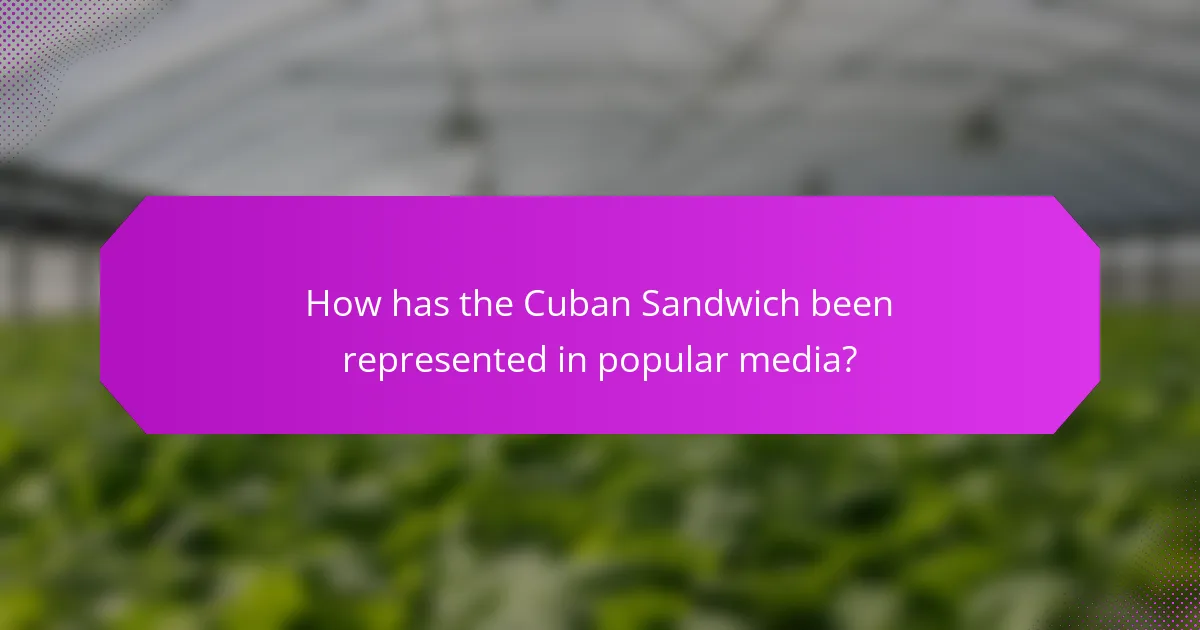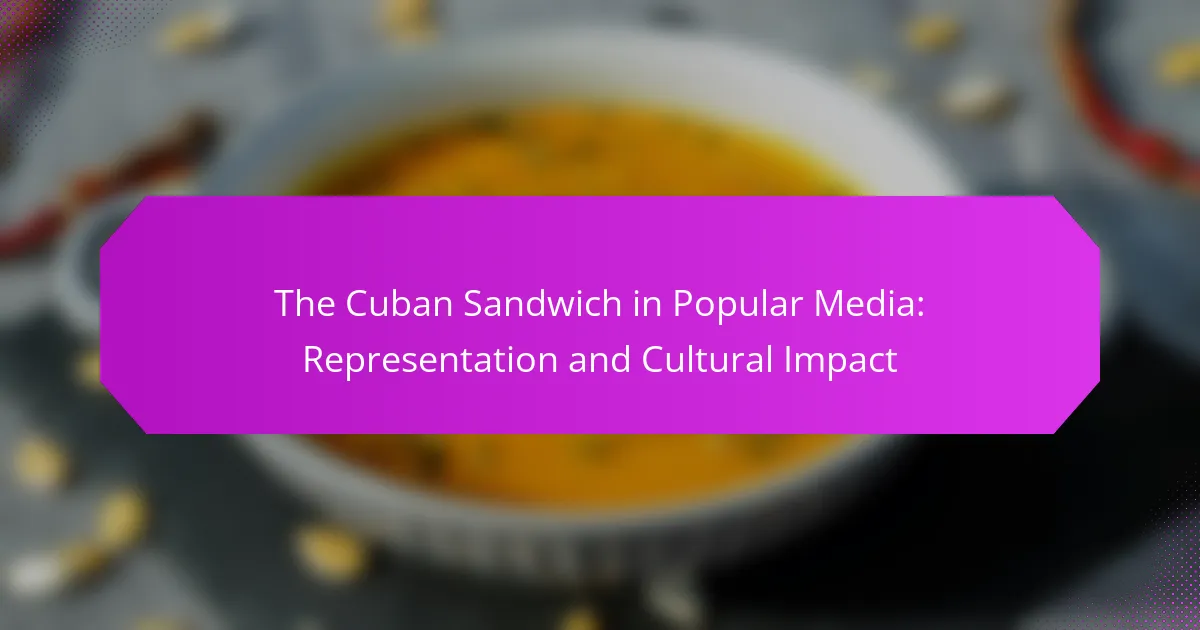The Cuban sandwich is a pressed sandwich made with Cuban bread, roast pork, ham, Swiss cheese, pickles, and mustard, originating from Cuban immigrants in Florida during the late 19th century. This article explores the Cuban sandwich’s representation in popular media and its cultural impact, highlighting its significance within the Cuban-American community and American cuisine at large. It examines how the sandwich has been featured in food documentaries, television series, and culinary awards, emphasizing its role as a symbol of heritage and identity. Additionally, the article discusses the sandwich’s influence on food festivals and culinary innovation, showcasing its broader appeal and contributions to cultural pride.

What is the Cuban Sandwich and its origins?
The Cuban sandwich is a pressed sandwich made with Cuban bread, filled with roast pork, ham, Swiss cheese, pickles, and mustard. Its origins trace back to Cuban immigrants in Florida, particularly in Tampa and Key West, during the late 19th century. The sandwich reflects the culinary influences of Cuban and Spanish cuisines. Over time, it became a popular dish in Cuban-American culture. The Cuban sandwich gained widespread recognition in the United States, especially in Miami, where it is often featured in local cuisine. This sandwich is celebrated for its unique combination of flavors and textures. Its popularity has led to various interpretations and adaptations across different regions.
How did the Cuban Sandwich evolve over time?
The Cuban Sandwich evolved from a blend of Cuban and immigrant influences in Florida. Its origins trace back to the late 19th century in Key West and Tampa. The sandwich initially featured Cuban bread, roast pork, and ham. Over time, it incorporated Swiss cheese and pickles. The addition of mustard became common in the early 20th century. Variations emerged as different communities added their unique touches. The Cuban Sandwich gained popularity in the 1960s, especially in Miami. Today, it is celebrated as a symbol of Cuban-American culture.
What ingredients define a traditional Cuban Sandwich?
A traditional Cuban sandwich is defined by several key ingredients. It typically includes Cuban bread, which is a white bread with a crispy crust. The sandwich is filled with layers of roast pork, which is marinated in a citrus-garlic sauce. Additionally, it contains ham, which adds a savory flavor. Swiss cheese is melted within the sandwich, providing creaminess. Pickles are also included, adding a tangy contrast. Finally, mustard is spread on the bread for extra zest. These ingredients come together to create a distinctive flavor profile that is characteristic of Cuban cuisine.
How do regional variations of the Cuban Sandwich differ?
Regional variations of the Cuban Sandwich differ primarily in their ingredients and preparation methods. In Tampa, the Cuban Sandwich often includes Genoa salami, reflecting the Italian influence in the area. Miami versions typically feature just roast pork, ham, Swiss cheese, pickles, and mustard, adhering to the traditional Cuban recipe. Additionally, some regions may use different types of bread, with Tampa sometimes opting for a softer Cuban bread. These variations highlight local tastes and cultural influences, showcasing how the Cuban Sandwich adapts to different communities. The differences in ingredients and methods illustrate the sandwich’s evolution across regions while maintaining its core identity.
Why is the Cuban Sandwich significant in Cuban culture?
The Cuban Sandwich is significant in Cuban culture as it represents a fusion of diverse culinary influences. This sandwich combines elements from Spanish, African, and Cuban cuisines. It typically features layers of roast pork, ham, Swiss cheese, pickles, and mustard on Cuban bread. The Cuban Sandwich emerged in the late 19th century, reflecting the cultural melting pot of Cuba. It became a staple among Cuban workers and immigrants, symbolizing their identity and heritage. The sandwich is often associated with social gatherings and celebrations, reinforcing community bonds. Its popularity has spread globally, showcasing Cuban culture to a wider audience. The Cuban Sandwich is not just food; it embodies the history and resilience of the Cuban people.
What role does the Cuban Sandwich play in Cuban identity?
The Cuban Sandwich is a symbol of Cuban identity and culture. It reflects the island’s culinary heritage and the fusion of various influences. The sandwich combines ingredients like roast pork, ham, Swiss cheese, pickles, and mustard, showcasing the diverse cultural elements present in Cuban cuisine. Its popularity in Cuba and among Cuban communities abroad reinforces a sense of belonging and pride. The Cuban Sandwich is often featured in cultural celebrations and gatherings, further solidifying its role in communal identity. Additionally, it serves as a culinary ambassador, introducing Cuban culture to a wider audience. The dish’s historical roots trace back to the 19th century, linking it to the experiences of Cuban immigrants. Thus, the Cuban Sandwich plays a vital role in expressing and preserving Cuban identity.
How is the Cuban Sandwich celebrated in Cuban traditions?
The Cuban Sandwich is celebrated in Cuban traditions as a symbol of cultural identity and culinary heritage. It is often featured in family gatherings and community events, reflecting the importance of food in social bonding. The sandwich combines various ingredients, including roast pork, ham, Swiss cheese, pickles, and mustard, showcasing a blend of flavors that represent Cuban cuisine.
Cuban-Americans often enjoy Cuban Sandwiches during festivities, such as National Cuban Sandwich Day, celebrated on August 23rd. This day highlights the sandwich’s significance in Cuban culture and promotes its appreciation beyond the Cuban community. The Cuban Sandwich has also been featured in popular media, further solidifying its status as a cultural icon.
In essence, the Cuban Sandwich is not just a meal; it embodies the spirit of Cuban traditions and serves as a culinary ambassador of Cuban culture.

How has the Cuban Sandwich been represented in popular media?
The Cuban Sandwich has been represented in popular media as a symbol of Cuban culture and culinary tradition. It frequently appears in food documentaries and cooking shows, highlighting its cultural significance. For example, the sandwich was featured in the PBS series “Sandwiches That You Will Like,” showcasing its ingredients and preparation. Additionally, it has been mentioned in films and television series that depict Cuban-American life, emphasizing its role in identity and heritage. The Cuban Sandwich has also inspired numerous articles and blogs, celebrating its unique flavors and history. Overall, its representation reflects broader themes of cultural pride and fusion in American cuisine.
What films and television shows feature the Cuban Sandwich?
The Cuban Sandwich appears in several films and television shows. Notable examples include the movie “Chef,” where the main character creates a Cuban Sandwich food truck. The series “The Simpsons” features a Cuban Sandwich in an episode focused on food culture. Additionally, “The Great Food Truck Race” highlighted Cuban Sandwiches as part of a culinary challenge. These instances showcase the sandwich’s cultural significance and popularity in media.
How are the cultural implications of the Cuban Sandwich portrayed in these media?
The cultural implications of the Cuban Sandwich are portrayed as symbols of Cuban identity and heritage in various media. In films and television, the sandwich often represents the immigrant experience and cultural fusion. It showcases the blend of flavors from different cultures, highlighting the historical significance of Cuban migration to the United States. Documentaries and food shows emphasize the sandwich’s role in community gatherings and celebrations, reinforcing its cultural importance. Additionally, social media often features the Cuban Sandwich as an emblem of pride for Cuban-Americans, promoting culinary traditions. This portrayal reflects a broader narrative of cultural resilience and adaptation within the Cuban-American community.
What messages are conveyed about Cuban culture through the depiction of the Cuban Sandwich?
The Cuban sandwich conveys messages about Cuban culture, emphasizing its rich culinary heritage. This sandwich reflects the fusion of Spanish, African, and indigenous influences in Cuban cuisine. The use of specific ingredients like roasted pork, ham, Swiss cheese, pickles, and mustard symbolizes the diverse cultural interactions within Cuba. Additionally, the Cuban sandwich serves as a representation of community and shared experiences, often enjoyed in social settings. Its popularity in both Cuba and the Cuban diaspora highlights the importance of food as a cultural connector. The sandwich also illustrates the resilience of Cuban identity, adapting to various contexts while maintaining its distinct flavor. Overall, the Cuban sandwich encapsulates the essence of Cuban culture through its unique ingredients and communal significance.
How has the Cuban Sandwich influenced food trends in popular culture?
The Cuban Sandwich has significantly influenced food trends in popular culture. Its rise in popularity has led to a greater appreciation for Cuban cuisine in the United States. The sandwich has inspired food festivals and culinary events celebrating Cuban flavors. Chefs across the country have incorporated its elements into new dishes. This trend reflects a broader interest in fusion cuisine and diverse food experiences. The Cuban Sandwich has also been featured in films and television, increasing its visibility. Popular media portrayals have introduced the sandwich to wider audiences, further solidifying its cultural impact. The sandwich’s unique combination of ingredients has encouraged experimentation in sandwich-making nationwide.
What are the notable adaptations of the Cuban Sandwich in contemporary cuisine?
Notable adaptations of the Cuban Sandwich in contemporary cuisine include variations that incorporate local ingredients and culinary styles. For instance, the addition of avocado or guacamole reflects a trend towards fresher toppings. Some chefs use different types of bread, such as ciabatta or sourdough, instead of the traditional Cuban bread.
Vegetarian versions have emerged, substituting meat with plant-based proteins like jackfruit or tofu. Additionally, gourmet takes may feature artisanal cheeses or specialty mustards. Regional influences can also be seen, with some adaptations incorporating elements from other cuisines, such as a barbecue Cuban Sandwich. These variations showcase the sandwich’s versatility and its ability to evolve within modern culinary landscapes.
How do food critics and influencers perceive the Cuban Sandwich?
Food critics and influencers generally perceive the Cuban Sandwich as a flavorful and culturally significant dish. They appreciate its combination of roasted pork, ham, Swiss cheese, pickles, and mustard, which creates a unique taste profile. Critics often highlight the sandwich’s origins in Cuban culture, emphasizing its role as a symbol of Cuban-American identity. Influencers frequently showcase the Cuban Sandwich on social media, celebrating its visual appeal and robust flavors. Reviews from sources like Eater and Thrillist praise its balance of textures and flavors. Overall, the Cuban Sandwich is regarded as a must-try for food enthusiasts.

What is the cultural impact of the Cuban Sandwich beyond media representations?
The Cuban Sandwich serves as a significant cultural symbol within the Cuban-American community. It represents heritage and identity, bridging generations through culinary tradition. The sandwich fosters community gatherings and celebrations, reinforcing social bonds. Its popularity extends beyond Cuban culture, influencing broader American cuisine. This influence is evident in the rise of food festivals celebrating Cuban cuisine. The Cuban Sandwich has also inspired chefs to innovate and incorporate its elements into diverse dishes. Furthermore, it has become a culinary ambassador, promoting Cuban culture globally. This cultural significance is underscored by its inclusion in various culinary awards and recognitions, highlighting its role in American gastronomy.
How does the Cuban Sandwich contribute to culinary tourism?
The Cuban Sandwich significantly contributes to culinary tourism by attracting food enthusiasts to experience its unique flavors. This sandwich, featuring layers of roasted pork, ham, Swiss cheese, pickles, and mustard on Cuban bread, showcases Cuban culinary traditions. Tourists often seek authentic local cuisine, and the Cuban Sandwich serves as a cultural symbol of Miami and Cuba. Its popularity has led to numerous restaurants and food festivals celebrating this dish. According to the Greater Miami Convention & Visitors Bureau, culinary tourism accounts for a substantial portion of visitors’ spending in the area. The Cuban Sandwich has also been featured in popular media, further enhancing its visibility and appeal. This increased exposure drives tourists to seek out authentic experiences centered around this iconic sandwich.
What are the best places to experience authentic Cuban Sandwiches?
Versailles Restaurant in Miami is renowned for its authentic Cuban sandwiches. This restaurant has been serving Cuban cuisine since 1971. It is often referred to as the “most famous Cuban restaurant in the world.” Another top spot is La Carreta, also in Miami. It offers a traditional Cuban sandwich that locals rave about. In Tampa, the Columbia Restaurant is a historic venue known for its Cuban sandwich. Established in 1905, it emphasizes authentic flavors. Additionally, El Exquisito in Little Havana is praised for its homemade bread and flavorful fillings. These establishments are celebrated for their dedication to traditional recipes and quality ingredients.
How does the Cuban Sandwich foster community and connection among food lovers?
The Cuban Sandwich fosters community and connection among food lovers by serving as a cultural symbol and a shared culinary experience. It represents the fusion of diverse cultural influences, primarily Cuban and Spanish, which resonates with many food enthusiasts. Food lovers often gather at local eateries or food festivals to enjoy Cuban Sandwiches together. This shared enjoyment encourages conversations and connections among people with similar tastes. Events centered around Cuban food also promote cultural appreciation and awareness. The sandwich’s popularity has led to social media groups and online forums where fans exchange recipes and experiences. These interactions strengthen bonds within the community, highlighting the sandwich’s role in bringing people together.
What are some tips for making an authentic Cuban Sandwich at home?
To make an authentic Cuban sandwich at home, use Cuban bread for the base. Cuban bread is a white bread that is slightly crispy on the outside and soft on the inside. Layer the sandwich with roasted pork, ham, Swiss cheese, and pickles. Roasted pork should be marinated in a citrus-garlic marinade for flavor. Use yellow mustard to enhance the taste. Press the sandwich in a plancha or a heavy skillet to achieve a crispy texture. Cook until the cheese melts and the bread is golden brown. Authentic Cuban sandwiches are a staple in Cuban cuisine, reflecting the island’s culinary heritage.
What common mistakes should be avoided when preparing a Cuban Sandwich?
Common mistakes to avoid when preparing a Cuban sandwich include using the wrong bread. The ideal bread is Cuban or a similar soft, white bread. Another mistake is not pressing the sandwich sufficiently. Proper pressing ensures even melting of cheese and a crispy exterior. Additionally, overloading the sandwich with ingredients can lead to sogginess. A balanced filling of pork, ham, cheese, pickles, and mustard is essential. Using non-traditional ingredients, like mayonnaise, strays from the authentic recipe. Lastly, neglecting to toast the sandwich can result in a lackluster texture. Each of these mistakes can compromise the sandwich’s authentic flavor and experience.
How can variations of the Cuban Sandwich be created while respecting tradition?
Variations of the Cuban Sandwich can be created by incorporating different ingredients while maintaining core elements. The traditional Cuban Sandwich consists of Cuban bread, roast pork, ham, Swiss cheese, pickles, and mustard. To respect tradition, any variation should retain these foundational components.
For example, one might use different types of bread, such as bolillo or ciabatta, while keeping the original fillings. Another approach is to introduce new flavors, like adding avocado or jalapeños, but still using the classic meats and cheese.
These adaptations should be mindful of the Cuban Sandwich’s cultural significance. Historical context shows that the Cuban Sandwich originated in the Cuban immigrant communities in Florida, emphasizing its roots. Therefore, any variation should celebrate and honor that heritage.
Respecting tradition while innovating can attract diverse palates without losing the essence of the Cuban Sandwich.
The Cuban sandwich is a pressed sandwich made from Cuban bread, filled with roast pork, ham, Swiss cheese, pickles, and mustard, originating from Cuban immigrants in Florida in the late 19th century. This article explores the Cuban sandwich’s representation in popular media, its cultural significance, and its evolution over time, highlighting its role as a symbol of Cuban identity and culinary heritage. Additionally, it examines regional variations, adaptations in contemporary cuisine, and the sandwich’s impact on food trends and culinary tourism. The Cuban sandwich not only serves as a beloved dish but also fosters community connections and cultural appreciation among food lovers.
